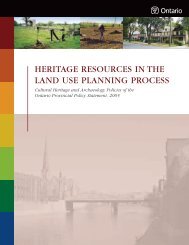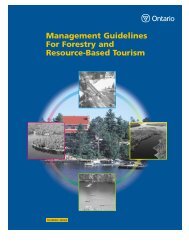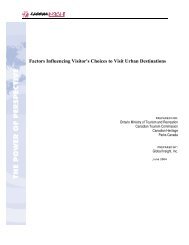Heritage Conservation Principles for Land Use Planning
Heritage Conservation Principles for Land Use Planning
Heritage Conservation Principles for Land Use Planning
You also want an ePaper? Increase the reach of your titles
YUMPU automatically turns print PDFs into web optimized ePapers that Google loves.
• InfoSheet •<br />
<strong>Heritage</strong><br />
<strong>Conservation</strong><br />
<strong>Principles</strong> <strong>for</strong><br />
<strong>Land</strong>use <strong>Planning</strong><br />
The Province of Ontario has<br />
developed a new policy<br />
statement pursuant to section<br />
3 of the <strong>Planning</strong> Act - (the<br />
Provincial Policy Statement,<br />
2005) which municipal land<br />
use planning decisions are to<br />
be consistent with. The<br />
Provincial Policy Statement,<br />
2005 includes specific policies<br />
on the conservation of built<br />
heritage resources, cultural<br />
heritage landscapes and<br />
archaeological resources (PPS<br />
2005 - Policy Section 2.6).<br />
Increasingly, Municipal<br />
<strong>Heritage</strong> Committees may be<br />
requested to advise planning<br />
departments and municipal<br />
councils on land use planning<br />
issues as these affect local<br />
heritage resources that have<br />
cultural heritage value or<br />
interest. The following core<br />
principles were developed to<br />
provide guidance to Municipal<br />
<strong>Heritage</strong> Committees.<br />
For more in<strong>for</strong>mation, please call the<br />
Ministry of Culture at (416) 212-0644<br />
or Toll Free at 1-866-454-0049 or<br />
refer to the website at<br />
www.culture.gov.on.ca.<br />
Spring 2007<br />
Disponible en français<br />
Timeliness<br />
It is important to identify heritage conservation issues at the beginning of the<br />
planning process and to make continuous reference to heritage conservation<br />
issues throughout the decision making process.<br />
Value/Significance<br />
Respect <strong>for</strong> the significance of the resource must be taken into consideration<br />
at every step in the planning and decision-making process.<br />
Respect the cultural values of the community <strong>for</strong> whom the resource has<br />
significance. Evaluation of significance should reflect consensus among<br />
community members with an interest in the preservation, use and<br />
development of cultural heritage.<br />
Evaluation must be based on proper research. Evaluation clarifies where<br />
significance or value lies in cultural heritage and how that significance is<br />
expressed.<br />
Inclusiveness<br />
Look at the community as a whole be<strong>for</strong>e you look at individual parts.<br />
Consider both tangible heritage resources such as structures and artifacts and<br />
intangible heritage resources such as cultural expressions, stories, songs etc.<br />
In a community, a heritage resource is part of a whole system which includes<br />
the natural environment and human activities. The activities of one part may<br />
affect the other parts. Have concern <strong>for</strong> maintaining the integrity of the whole<br />
system.<br />
Encourage approaches to planning that are sustainable, that minimize<br />
negative long-term impacts on the social, cultural, economic and physical<br />
aspects of cultural heritage resources.<br />
Respect <strong>for</strong> Context<br />
The surroundings or setting of a cultural heritage resource often contribute to<br />
its significance and vice versa. Where significance is linked to the contextual<br />
value of the resource, try to preserve the context.<br />
Try to maintain the same use <strong>for</strong> a heritage resource, or if this is not possible,<br />
find a compatible new use that does not demand too much change to the<br />
resource's physical fabric.<br />
Page 1 of 2
• InfoSheet •<br />
<strong>Heritage</strong> <strong>Conservation</strong> <strong>Principles</strong> <strong>for</strong> <strong>Land</strong>use <strong>Planning</strong><br />
Retention<br />
The decision making process should always presume in favour of retaining<br />
the heritage resource. The only exception to this rule is when there is a<br />
demonstrated public benefit of greater importance than the protection of the<br />
heritage resource.<br />
The significance, type, use and condition of a resource should be considered<br />
as part of the decision making process. Only allow changes that will offer the<br />
least harm to the resource or will provide the greatest potential to enhance its<br />
significance and appreciation.<br />
Where negative impacts are unavoidable, effective mitigation must be applied<br />
including reusing and making sympathetic alterations, reconstruction, moving<br />
to an appropriate setting, commemoration on site or elsewhere, or recording<br />
the resource be<strong>for</strong>e any negative changes are made.<br />
Caution<br />
Avoid decisions that will damage or harm the fabric of cultural heritage<br />
resources and their settings. <strong>Use</strong> approaches that offer the least risk to the<br />
fabric of the resource. Consider sympathetic alterations or reversible changes<br />
to it.<br />
Give priority to measures that improve conditions <strong>for</strong> long-term conservation:<br />
focus on maintenance of parts, setting, function or use.<br />
Ensure that approaches proposed <strong>for</strong> conservation have been proved reliable<br />
and effective and that they constitute good practice.<br />
Public Benefit<br />
To understand and appreciate cultural resources, the public should be<br />
provided with accurate interpretation of the resource, through in<strong>for</strong>mation that<br />
effectively communicates the importance and value of the resource.<br />
The in<strong>for</strong>mation contained in this InfoSheet should not be relied upon as a substitute<br />
<strong>for</strong> specialized legal or professional advice in connection with any particular matter.<br />
© Queen's Printer <strong>for</strong> Ontario, 2007.<br />
If credit is given and Crown copyright is acknowledged, this material may be<br />
reproduced <strong>for</strong> non-commercial purposes. Page 2 of 2


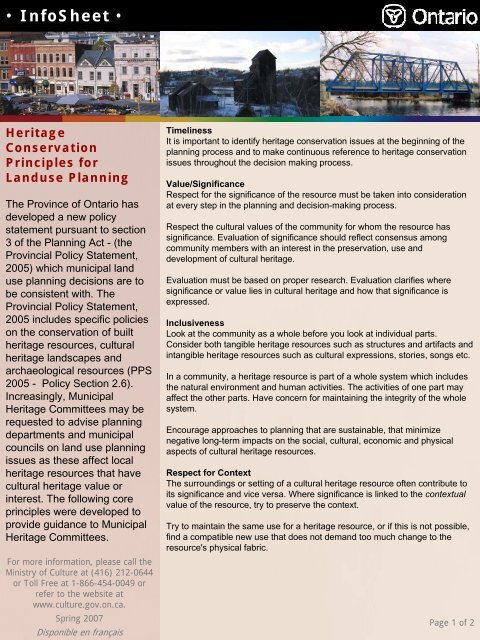
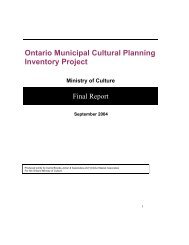
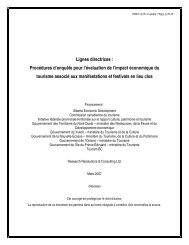
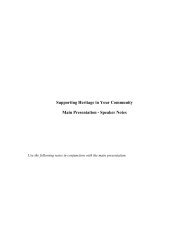
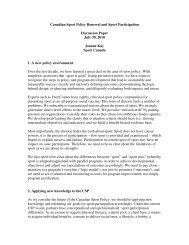
![THIS AGREEMENT made this [date], between [name of owner] (the ...](https://img.yumpu.com/49827605/1/158x260/this-agreement-made-this-date-between-name-of-owner-the-.jpg?quality=85)


